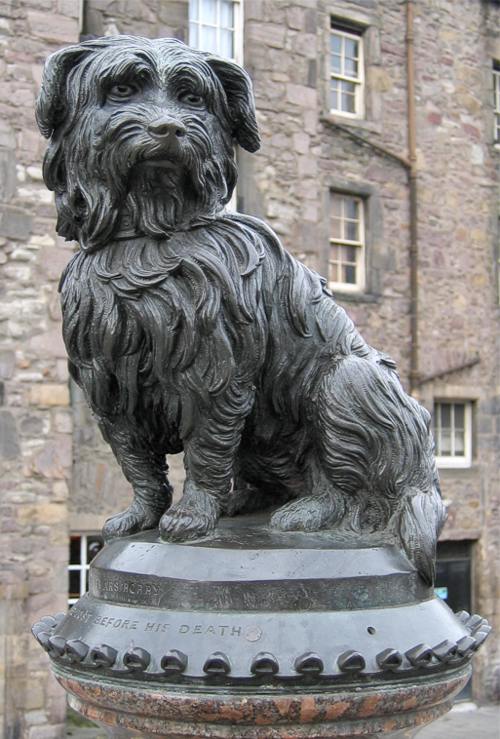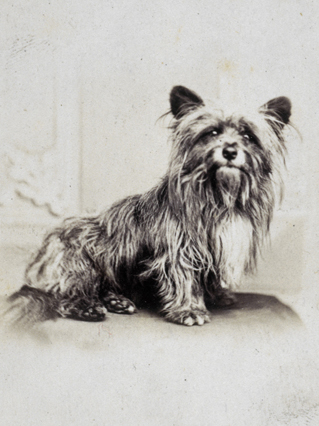
Wikimedia Commons
Greyfriars Bobby was a Skye Terrier who supposedly spent fourteen years guarding the grave of his owner in 19th-century Edinburgh, until his own death on 14 January 1872. The story continues to be well known in Scotland, and has been the subject of several books and films.
The “cult” of Greyfriars Bobby began with a feature in the Scotsman newspaper dated 13 April 1867, which was re-published by other provincial and national newspapers.[2][b]Jan Bondeson has suggested that April 1867 was a slow news period, and had it not been very few would have heard of Greyfriars Bobby.[3]
Although there is no doubt that Greyfriars Bobby really existed, some commentators have cast doubt on certain aspects of the story. One issue is that for the account to be true, Bobby would had have to have lived for between sixteen and eighteen years;[4] according to The Kennel Club, twelve years would be a good lifespan for the breed.[5] This and other anomalies have led to the suggestion that the first Greyfriars Bobby died in 1867, following which the dog was replaced by a surrogate.[4]
Traditional story
The common version of the story originates from the account of a case in Edinburgh’s Burgh Court, published in The Scotsman newspaper on 13 April 1867. John Traill, owner of Traill’s Temperance Coffee House just outside Greyfriars Kirk, was accused under the Dog Duty Act of 1867 of harbouring an unlicenced dog, Greyfriars Bobby. Facing the penalty of a £5 fine,[c]The tax on a dog was an initial seven shillings followed by an annual payment of five shillings.[6] Traill explained to the court that the dog was well known locally for his fidelity in remaining at his master’s grave, and that for many years Bobby had been visiting his premises daily looking for a meal. A witness for the defence, Thomas Cowan, the licencee of the Hole in the Wall public house opposite the kirkyard, stated that he also sometimes fed the dog.[7]
The curator of Greyfriars, James Brown, described as “old and in poor circumstances”, stood up and offered to pay the dog tax himself, rather than have Bobby “put out of the way” as he described it.[7][d]The Dogs Act gave the authorities the right to euthanase unlicensed stray dogs.[7]
Memorials
The Greyfriars Bobby Fountain in Edinburgh includes a life-size statue of Greyfriars Bobby created by William Brodie. It was paid for by a local philanthropist, Baroness Burdett-Coutts, and unveiled on 15 November 1873.[8][9] Edinburgh’s smallest listed buildingStructure of particular architectural and/or historic interest deserving of special protection., it stands near the south (main) entrance to Greyfriars Kirkyard. It had an upper fountain for humans and a lower fountain for dogs, but its water supply was cut off (together with Edinburgh’s other drinking fountains) in about 1975 owing to health scares.[8] The monument was fully restored under the supervision of Edinburgh District Council in 1985. A plaque on the base reads:
Inscribed on the statue is “Greyfriars Bobby, from the life just before his death” and “W.H. Brodie Sc RSA 1872”.[8]
A red granite monument was erected close to Bobby’s grave by The Dog Aid Society of Scotland and unveiled by the Duke of Gloucester on 13 May 1981.[1][10] An insciption on the monument reads: “Greyfriars Bobby – Died 14 January 1872 – Aged 16 years – Let his loyalty and devotion be a lesson to us all”.[11]
Greyfriars Bobby’s collar and bowl are on display at the Museum of Edinburgh, formerly known as Huntley House Museum.[12]
Notes
| a | Designation LB27899[1] |
|---|---|
| b | Jan Bondeson has suggested that April 1867 was a slow news period, and had it not been very few would have heard of Greyfriars Bobby.[3] |
| c | The tax on a dog was an initial seven shillings followed by an annual payment of five shillings.[6] |
| d | The Dogs Act gave the authorities the right to euthanase unlicensed stray dogs.[7] |

